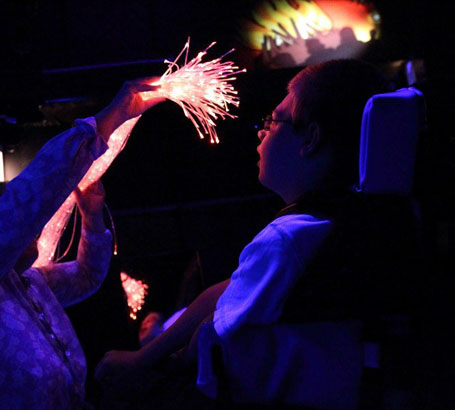
Question: Why is it so important to elevate teaching the arts to those with SLD/PMLD/CLDD?
An answer: It may well be insufficient to apportion time to the arts - particularly music, drama, art and dance - as one might in a mainstream setting. Here, these subjects will find their own place in a competing list of options, all of which are designed to maximise thinking and deep learning. Drama and dance are, after all, not even subjects in their own right, but are part of English and PE respectively.
For the child, young person and adult with severe and complex learning difficulties, however, these areas of learning may be the primary means of maximising thinking and deep learning, especially because, by their very nature, they are designed to get children to think in a symbolic and abstract manner.

It is well established that those with severe learning difficulties find abstraction extremely difficult (Imray, 2006; Lacey, 2010) and that 'best practice' usually encourages using concrete teaching approaches. Certainly, this module urges teachers to teach independent living skills by actually going to the shops, actually getting dressed, actually cooking a pizza from scratch, actually smelling clothes to test whether they need washing. These are not things that will be learned easily by watching a DVD or filling in a work sheet or using plastic money in the classroom.
In these areas, we can teach problem-solving and thinking skills by setting up and establishing the routine and then deliberately 'sabotaging': leading pupils towards recognising, dealing with and learning by the problem.

The arts, however, approaches thinking and problem solving from another direction, by putting the learner into other bodies and other thought processes and by approaching experience from various and differing directions. The arts are entirely accessible to all, intrinsically motivating, excellent vehicles for inclusive teaching, and provide valuable opportunities for self-fulfilment and boosting self esteem. Why would we not want the arts to form a major part of any SLD curriculum?
Cahill (1992) talks of the arts as being an excellent vehicle for raising children's self-confidence, enabling them to achieve without writing in situations where there is no right and wrong. Another writer says the arts are essentially:

concerned with making and sharing meanings, and stimulate
a process of personal growth. Arguably they give form and expression to an inner drive to externalise images; perhaps we all
have some inner need to communicate, to find forms of expression and to symbolise or encapsulate our experiences; ways in
which we may all find a sense of personal validation. In schools we need to ensure that they are achievable by ensuring that
children of all abilities develop confidence and appropriate skills.
Peter, 1998
In a similar vein:

The capacity for all art forms to motivate, to encourage
self esteem, to stimulate the imagination, curiosity, and encourage children generally to investigate, are major outcomes
of any learning experience for a child with severe learning difficulties.
Carpenter and Hills, 2002
Peter also suggests that the arts improve thinking in terms of fluency, flexibility, originality and elaboration. She argues that pupils tend to find the arts inherently motivating, perhaps because there is a 'strong notion of empowering pupils to take control and responsibility in the learning process'.
Andrew Cowries, of James Rennie School in Carlisle, was delighted with the boost to his pupils' self-esteem after they took part in the Shakespeare Schools' Festival:

the knock-on effect was profound. To be part of a national
event, performing in a real theatre, in front of an unknown audience gave them a powerful sense of certainty and purpose
Lancaster, 2006

Potentially the arts offer all children the opportunity
to integrate their knowledge, skills and understanding. A child will paint or draw what he or she has experienced, but will
also experience what he or she paints, thus prompting further responses and making connections. The arts offer the potential
to work in a multi-layered way, in contexts that are motivating, meaningful and energising. It is possible to capitalise on
their inherent playfulness (the natural way all children learn).
Peter, 1998

Cahill, M. (1992) The arts and special educational needs. Arts Education. December Issue: 12-15.
Carpenter, B. and Hills P (2002) Rescuing the Arts: The Sunmoves project. The SLD Experience. 32: 22-24.
Lancaster, K. (2006) Shakespeare - 'In Other Words'. The SLD Experience. 44: 3-4.
Peter, M. (1998) 'Good for them, or what?' The arts and pupils with SEN. British Journal of Special Education. 25 (4) 168-172.
Peter, M. (1998b) Accessing the curriculum through the arts for pupils with special educational needs. Support for Learning. Vol 13 No 4. pp153-156